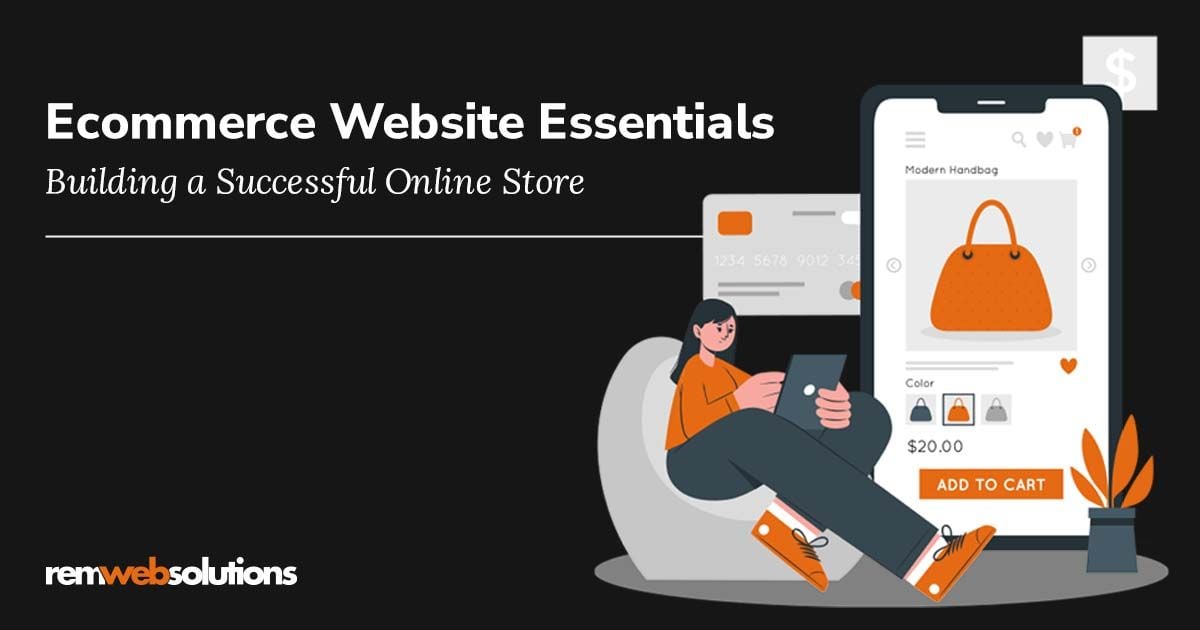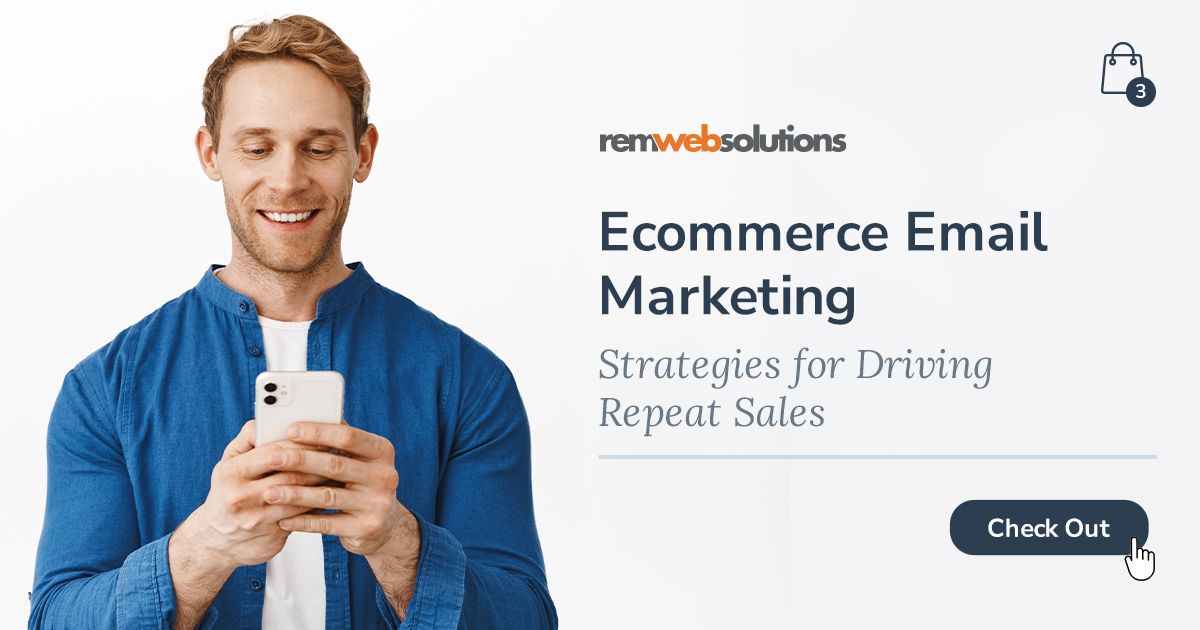
Your e-commerce website is your digital storefront, billboard, and salesperson all rolled in one. How do you make sure it stands out in this ever-expanding online marketplace?
Whether you're just starting your e-commerce website or looking to give your online shop a boost, we've got you covered.
From crafting irresistible product descriptions to mastering the art of the landing page, we're diving into the nitty-gritty e-commerce essentials for building a successful online store:
Product Descriptions
Structured Data
Landing Pages
Reviews
Blog Posts
Calls to Action
Usability and Web Design
At REM Web Solutions Inc., we thrive on helping our customers grow their businesses in tangible and impactful ways. If you need support with your digital marketing efforts or website design and development, don’t hesitate to reach out. Our skilled team is always here to support you in navigating the digital landscape!
1. Irresistible Product Descriptions
Your product might be the next big thing, but if it's hiding on page 10 of Google, who's going to know?
Your product descriptions are like your frontline sales team.
The better they are at explaining what you've got and why it's great, the more your customers will understand and appreciate your products.
Here's how to give your products the spotlight they deserve:
Know Your Audience: Dive deep into what your customers are looking for. What excites them about your products? What questions might they have? Your descriptions should talk directly to these points.
More than Just Features: Sure, the features are important, but how do your products make life better? Spell out the benefits clearly and attractively.
Speak Their Language: Use language that connects with your customers emotionally. Get them to imagine the experience of using your products.
SEO Smart: Sprinkle relevant SEO keywords throughout, but keep it natural. Remember, you're writing for humans first, search engines second.
Make it Snappy: Break down your descriptions into bite-sized, easy-to-digest pieces. Bullet points, subheadings, and the like are your friends.
Learn more about the importance of product descriptions.
2. Structured Data that Makes Your Site Stand Out
Ever wondered how some websites get those fancy results on Google with star ratings, images, and all? That's structured data at work.
Think of structured data, or Schema Markup, as a behind-the-scenes code added to your website that acts like a translator for search engines, helping them know exactly what your e-commerce website is selling.
Relevant Schema Markup for e-commerce websites includes:
Local Business Info: Let Google know the nitty-gritty about your business - where you are, when you’re open, and more. This can put you on the map, literally.
Product Details: From the ink you sell to the equipment you recommend, tell Google everything - prices, names, descriptions, images, stock status, and more. This can make your products pop in search results.
Reviews: Got great reviews? Schema markup helps Google understand and showcase these reviews right in the search results.
Breadcrumb Trails: This is about helping Google understand your website’s structure. Better structure can mean better search visibility.
Site Search & Videos: If you’ve got a search function or videos on your site, structured data helps Google show these in search results too.
Learn more about how to optimize your website for search engines.
3. Landing Pages that Turn Clicks into Customers
So, you've got an ad that's catching eyes. Great! But where do you take these potential customers next? That's where a landing page comes in.
A landing page is a standalone page designed specifically for your marketing campaign. Think of it as a focused conversation with your visitor about one thing and one thing only: your offer.
Now, you might think, "I've got a beautiful home page, why not just send them there?" Your home page is about your business as a whole. It’s a mix of everything. But when it comes to specific offers, it's too easy for visitors to get lost or distracted. A landing page keeps them on track, steering them exactly where you want them to go: towards a conversion.
Research shows that pages with a single call to action outperform those with multiple options. You want your visitors to do one thing, whether it's buying a product, signing up for a service, or grabbing a freebie. The clearer the path, the more likely they are to follow it.
Plus, landing pages do more than just convert. They:
Boost Your ROI: Every element on a landing page is geared towards your goal, making your ad spend more effective.
Gather Insights: Learn about your prospects. What do they like? What makes them click?
Easy Tracking: See how well your offers are doing. Tweak and improve based on real data.
Lead Management: Generate leads that you can categorize, nurture, or hand over to your sales team.
4. Reviews as Social Proof
In a world where we shop with our screens, reviews are the closest thing we have to trying something out in person. Reviews build trust and credibility, letting customers know that your product or service is the real deal.
This is about more than just feedback – it's about social proof. It's a psychological thing. We subconsciously look at what others do and think, "If it worked for them, it'll probably work for me."
Just having reviews at all is good, but here’s what really makes a good testimonial/review to feature or highlight:
Specifics are Key: Names, dates, numbers, real stories – these make a testimonial believable and relatable.
Real Stories, Real Impact: Share genuine narratives with vivid details. Let your customers tell their stories about how your product or service made a difference.
Document the Proof: If you can show real evidence or statistics, even better.
By the way, don't sweat the occasional negative review. In fact, a mix of good and not-so-good reviews can actually be more trustworthy. A perfect score might make people wonder if the reviews are genuine.
The occasional criticism adds authenticity, and how you respond to it can really show off your customer service skills.
5. Blog Posts Spotlighting Your Product
Think a blog is just for sharing your thoughts? Think again. For e-commerce, a blog can be a powerful salesperson:
Most buying decisions start with an emotion and end with a justification. Your blog is the perfect place to provide that justification. Share how your products are used, tell customer stories, and offer detailed, informative content.
Having a blog also means more opportunities to generate organic traffic:
Ranking for the Unrankable: Ever had great content ideas that just don't fit on a product page? A blog lets you rank for those important keywords that are related to your brand and products, but not directly sellable.
Grow Without Ads: Ads are great, but they cost. A blog, on the other hand, keeps pulling in visitors without ongoing ad spend.
Link It Up: Use your blog posts to link to your products and categories. It's a smart SEO play that can boost your rankings.
But don’t just dive into blogging without a plan! Start with keyword research. It helps you understand what your audience is searching for and ensures that every post you publish has the potential to attract organic traffic.
6. Powerful Calls to Action
Whether it's "Add to cart," "Learn more," or "Call now," your calls to action (CTAs) are there to guide users towards taking the action you want.
But there's a science to making them work:
Location, Location, Location: Where you place your CTA buttons is key. They should be easy to spot and reach. Think top of the page, left side, where eyes naturally go first. The goal is to grab attention effortlessly.
The Psychology of Colour: Colours aren't just for looks; they're about feelings and actions. Red for urgency, green for go, blue for trust, orange for energy. Choose your CTA colors wisely to match the action you want users to take.
Size and Shape Matter: Ever tried to tap a tiny button on your phone and missed? Frustrating, right? Your CTAs should be big enough to click easily, especially on mobile.
Adapt and Respond: Your CTAs should look and work great on any device. Responsive design ensures your buttons are just as clickable on a smartphone as they are on a desktop.
The right CTA can mean the difference between a tire-kick and a conversion. So, give your call-to-action buttons the attention they deserve! Make them clear, make them compelling, and watch them work their magic.
Learn more about creating effective call-to-action buttons in web design.
7. Brilliant e-Commerce Web Design
When it comes to your e-commerce website, think of design and usability as the dynamic duo. A site that nails this balance is like a welcoming storefront – easy to enter and hard to pry your attention away from.
Online shoppers are picky, and rightly so. They want a smooth, hassle-free experience. A clunky checkout? That's a surefire way to lose a sale. The goal is to keep your website’s functionality in sync with what customers expect and enjoy.
Your usability checklist must include:
Speed is Key: A slow site is a no-go. Optimize your page load times for a swift, seamless experience.
Be Device-Friendly: From desktops to smartphones, your site should look great and work well on any screen.
Optimize Everything: This means compressing images, minifying code, and using caching. The leaner your site, the faster it runs.
Inclusivity Matters: Make your website accessible to everyone. Use alternative texts for images and clear headings.
Simplified Navigation: Especially on mobile, make it easy to find what's needed with minimal taps and swipes.
Efficient Forms: Nobody likes long forms. Keep them short, sweet, and with clear error messages.
Clear and Concise: Get to the point. Use headings, subheadings, and bullet points for content that’s easy to scan.
Think User-First: Always put your audience's needs at the forefront. A site designed around your user is a site that succeeds.
Great web design is more than just a pretty face. It's a combination of aesthetic appeal and practical usability. By following these best practices, you create not just a website, but an that invites users in and makes them want to stay.
Your Path to E-Commerce Success
From crafting compelling product descriptions and leveraging the power of structured data to optimizing landing pages and harnessing the influence of social proof – we've covered a lot. Each element plays a vital role in creating an online store that's not just functional, but also engaging and successful.
At REM Web Solutions Inc., we understand the intricacies of creating an online presence that stands out. As a Digital Transformation Company, our focus goes beyond mere web design – we're about transforming your digital footprint. Whether it’s through eye-catching, user-friendly website designs or strategic online marketing, our goal is to help your business thrive in the digital age.
Ready to take your e-commerce store to the next level? Whether you're just starting out or looking to revamp your existing online store, our team at REM Web Solutions Inc. is here to guide you every step of the way. From seamless usability to cutting-edge design, we have the expertise to turn your digital dreams into reality.



























